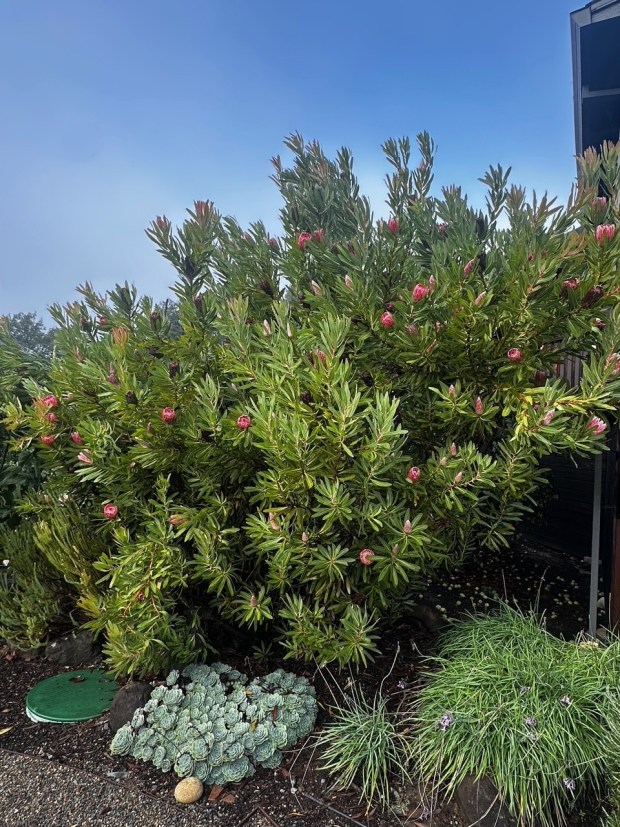
Christopher Downing – Sonoma County Master Gardener
Colorful proteas help brighten up the dreary winter. Christopher Downing – Sonoma County Master Gardener
At this time of year, when the summer’s bounty of dahlias, zinnias, cosmos and roses have started to fade from memory, I find myself scouring the garden for colorful flowers to brighten up the indoors during winter’s longer nights. Luckily, a few years back I took a chance on planting Protea leucadendron and leucospermum – both members of the Proteaceae family. November is the time of year they begin their succession of blooms to keep my vases full until springtime.
I initially chose these plants because they felt quirky – a little unexpected in the Sonoma landscape. The flowers of each plant vary, but they all share a bright palette of colors ranging from pale pinks, ivories and greens to vibrant orange, electric red, sunny yellows and moody burgundies. Leucospermum, known as pincushion Protea, often pairs two or three bright colors in one bloom, changing as it opens. Leucadendron has an atypical flower consisting of a cone surrounded by leaf-like bracts. The bracts show their most intense color in the cooler months while the foliage becomes brighter during warmer, sunny months. The bright grevillea flower, a magnet for hummingbirds and bees, has a long, slender shape some describe as “spidery.”
The Proteaceae plant family is among the oldest on earth, dating to over 90 million years, before the southern continents were fully separated. It grew on the land mass Gondwana from which Africa and Australia were formed, explaining why these two continents are home to the majority of Proteaceae plants.

Christopher Downing – Sonoma County Master Gardener
Beautiful proteas help brighten up a dreary winter garden. Christopher Downing – Sonoma County Master Gardener
Both Sonoma and Napa Counties enjoy a Mediterranean climate with warm, dry summers and mild, wet winters, which offer an ideal environment for many types of Protea. Here are some factors to consider if you want to try growing these plants in your garden.
Where to plant: Proteaceae like full sun and well-drained soil. The plants are susceptible to root rot, so amending heavier soils to improve drainage is essential. Planting on a hillside can also help with drainage.
When to plant: The best time to plant Proteaceae is during the fall (September to November) or spring (March to May). Planting in the fall allows the roots to establish before the winter rains, while spring planting aligns with the start of the growing season. Planting during the heat of summer is not ideal, as high temperatures can stress new plants.
What to plant: If you choose the right mix and variety of Proteaceae plants, you can have blooms nearly year-round. Leucadendron and leucospermum generally bloom from late winter to early spring, banksia in late spring to early summer and grevillea from early spring to late summer. Many Protea varieties bloom in early fall to early winter with some blooming in spring.
Protea thrive in nutrient-poor soils and don’t require fertilization. In fact, they’re highly sensitive to phosphorus and can be poisoned by general-purpose fertilizers. They’re also drought-tolerant, so once established require very little care beyond pruning and removing dead flowers.
Pruning should be done after flowers fade, often March/April. Cut below spent flowers just above a node, leaving 6-8” of stem and healthy leaves. Never cut old, leafless wood as it might not grow back. Cut at a 45-degree angle with sharp, sanitized shears.
Because Protea flowers come in a wide variety of shapes and colors, they really live up to the shape-shifting Greek god Proteus for whom they were named. They can be used in cut flower displays, dried flower bouquets, and as a new approach to holiday wreath making.
Contributors to this week’s column were Christopher Downing, Diane Judd and Joy Lanzendorfer. The UC Master Gardener Program of Sonoma County sonomamg.ucanr.edu/ provides environmentally sustainable, science-based horticultural information to Sonoma County home gardeners. Send your gardening questions to scmgpd@gmail.com. You will receive answers to your questions either in this newspaper or from our Information Desk. You can contact the Information Desk directly at 707-565-2608 or mgsonoma@ucanr.edu. To receive free gardening tips and news about upcoming events, sign up for our monthly newsletter: https://tinyurl.com/y3uynteb.


Comments are closed.